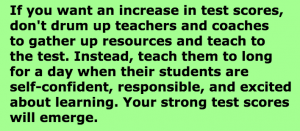Like it or not, to most schools, achievement means strong performance on state tests. Some claim to value life preparation and social-emotional growth over test scores, but that never plays well in the annual newspaper articles. What if you could have it all? What if you could rethink success and have happy, healthy, excited students from all walks of life, with strong test scores?
 I love to build sandcastles, particularly with young children, and I usually start with a large hole in the middle that hits the water (easier to retrieve wet sand). I begin by sharing a vision and a dream of a sandcastle; then I share the news that if we dig deep enough, we will hit water. The dream of hitting water from the sand on the shore is usually all it takes to energize my building partner (engagement). As the hole grows, there are skills to retrieving the wet sand and building up the walls. I coach in those skills and share my belief in my building partner’s ability to carry them out (empowerment).
I love to build sandcastles, particularly with young children, and I usually start with a large hole in the middle that hits the water (easier to retrieve wet sand). I begin by sharing a vision and a dream of a sandcastle; then I share the news that if we dig deep enough, we will hit water. The dream of hitting water from the sand on the shore is usually all it takes to energize my building partner (engagement). As the hole grows, there are skills to retrieving the wet sand and building up the walls. I coach in those skills and share my belief in my building partner’s ability to carry them out (empowerment).
Finally, the walls are in place and we begin the work of carving with shells (my dad always told me you carve away everything that doesn’t look like a castle). Soon, the castle begins to emerge. Now, my building partner spreads wings, creates, and shines with self-belief (efficacy), and the castle grows more and more awesome until there is no more sunlight to guide us. One of my favorite quotes:
If you want to build a ship, don’t drum up the men to gather up the wood, divide the work, and give orders. Instead, teach them to yearn for the vast and endless sea. —Antoine De Saint-Exupery
If you want an increase in test scores, don’t drum up teachers and coaches to gather up resources and teach to the test. Instead, teach them to long for a day when their students are self-confident, responsible, and excited about learning. Your strong test scores will emerge. Make these your goals:

Engage students with authentic, open-ended, problems to tackle related to the content to get them in “flow“: Get them grappling! Instead of focusing on the skill, focus on where they will use that skill, and start there.
Empower students by giving them increasing responsibility for their own learning. Let them decide which activities to pursue and when in order to learn the skills they need to accomplish the task that has engaged them.
Build student efficacy through leveling-up activities that continue to offer them success, building a belief in their ability to achieve a goal. Let them self-assess, set goals, and accomplish their goals. Essentially, facilitate their learning.
If you aim for engagement, empowerment, and efficacy, your students will be proud, happy, and excited about learning, and your test scores will rise! Perhaps success for our students is, in fact, engagement, empowerment, and efficacy.
And now, there’s a video on the topic, too!
